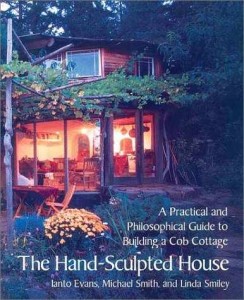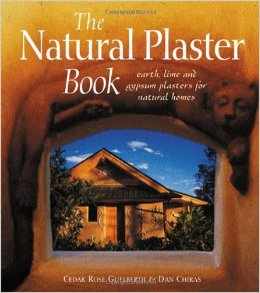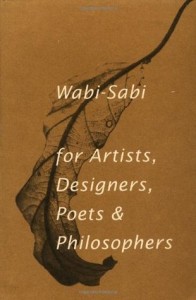There are lots of books out there about tiny homes and scaling back and living simply. These are just a selection of books that have been on our bookshelf (floor) for the last few months and helped shape our own tiny home. Click on the images for more information. Please feel free to share your favorites!
 Tiny Homes : Simple Shelter by Lloyd Kahn
Tiny Homes : Simple Shelter by Lloyd Kahn
Perhaps the book that started our fascination. It’s more eye-candy than anything, but it features dozens of tiny homes built largely by “amateurs”. It’s certainly a great place to dig into the possibilities of simpler and scaled back living. Lloyd Kahn is sort of a legend in thinking alternatively about one of our basic needs – shelter.
The Hand-Sculpted House by Ianto Evans, Linda Smiley and Michael G. Smith
Published by the folks that reintroduced cob as a building material in the United States, this is so much more than an how-to-book. In addition to step-by-step guides on transforming raw earth into a beautiful home, the founders of the Cob Cottage Company share insights on your home can work with nature instead of against it. Further, there are inspirational passages about empowerment and liberation and revolution. It is an exciting and enlightening read.
Compact Cabins by Gerald Rowan
This is another easy-to-flip-through eye-candy sort of book. It has nice floor diagrams and renderings of homes (cabins) ranging from around 150 square feet to about 1000. Get some ideas here before, during or after your build. Or just daydream about forest retreats and lake-side writing bungalows like we do.
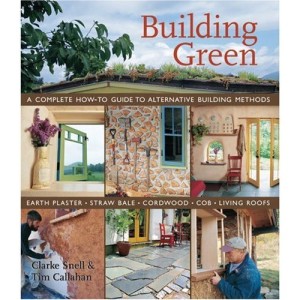 Building Green by Clarke Snell and Timothy L. Callahan
Building Green by Clarke Snell and Timothy L. Callahan
We didn’t use a lot of techniques featured in this book. But this is by far the best (read, most comprehenisve) resource we’ve seen for natural building practices (i.e. cob, straw bale, natural plasters, living roofs, etc). Lots of diagrams, theory, tips, tricks and anecdotes. A favorite aspect is an honest evaluation of whether or not what they’re doing is ‘green’. That word gets thrown around so much, that just about anything can be labeled as such. But what does it really mean? This book spends a lot of time trying to find out.
The Natural Plaster Book by Cedar Rose Guelberth & Dan Chiras
We’ll re-check this out from the library when we plaster some of our walls this spring.
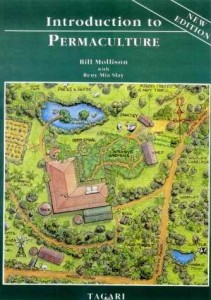 Introduction to Permaculture by Bill Mollison
Introduction to Permaculture by Bill Mollison
Permaculture, or permanent agriculture, makes a lot of sense to us. Use what you have. Work with nature, not against it. Work towards creating systems that take care of themselves. Try to close loops and eliminate need for exterior inputs (i.e. fuel, fertilizer, water). The principles apply equally to farming as they do to building your home. Your home shouldn’t be apart from its surroundings. It should be a part of it. This book introduces you to the concepts and practices of permaculture.
This is an introductory text to the Japanese aesthetic. It’s characterized by an appreciation of the way things occur in nature. Traits such as imperfection, asymmetry and simplicity in form and function are valued.
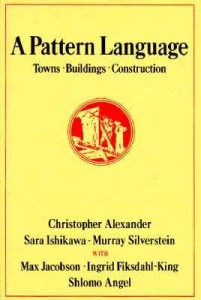
A Pattern Langauge by Christopher Alexander
This book has recently made its way to our shelves. We’re pretty well sold on a lot of the theory presented in this text. A lot of it is common sense that seems to have fallen out fashion: Design for humans on foot, not in cars. Make room for nature in all aspects of our built spaces. The book is so much more than theoretical rearrangements of civilization too. You could pick it up when you’re thinking about small remodels or even just how to arrange furniture or a garden plot.
OTHER READING RECOMMENDATIONS :
- Design / Practical Guides :
- Earthship by Michael Reynolds the mother of modern passive solar design.
- Permaculture :
- Gaia’s Garden by Toby Hemenway – taking the principles of permaculture to a small scale.
- Permaculture: A Designer’s Manual by Bill Mollison
- Water and Waste
- The Humanure Handbook by Joseph Jenkins – poop is too valuable to just flush it down the toilet.
- Water Storage : Tanks, Cisterns, Aquifers and Ponds by Art Ludwig
- Non – Fiction :
- Michael Pollan toes the line of journalistic objectivity and personal narrative exquisitely. Check out Second Nature: A Gardener’s Education and A Place of My Own for homesteading inspiration.
- James Howard Kunstler’s novel, A World Made By Hand, offers a hopeful glance into a post-oil future.
- Aldo Leopold
- Annie Dillard
- Social Essays / Philosophy : I’ll (Oliver) admit, these books are a bit soapboxy and ivory-towery. But, they do provide a framework for thinking critically about how we live and build our communities. They’re also pretty good about offering suggestions on how we might create a safer, freer, healthier world together.
- Jane Jacobs
- Wendell Berry
- James Howard Kunstler has also published a number of essays about designing human-scaled cities, neighborhoods and homes. Lots of interesting reads. Check out Geography of Nowhere and The City in Mind
OTHER RESOURCES: WORKSHOPS
- Mud Dauber School of Natural Building We took a ten-day intensive straw-bale workshop at 20 miles west of Chapel Hill, North Carolina. The school is set on a beautiful 10 acre lot surrounded by dozens and dozens more lush undeveloped acres of Carolina wildness.The food is incredible, the instructors, Greg and Danielle and Mike were outstanding. We highly recommend this experience.
